Blog | May 2020, Allegralabrotory
Magical afterlives in post-genocidal Turkey
by Çiçek İlengiz
This blog was originally published on 21 May 2020 in Allegralabrotory.
One enters the city of Dersim, surrounded by the steep holy Munzur Mountains in central Anatolia, after showing one’s ID at several security check points along the way. Some of these checkpoints exist since the Dersim Genocide (1937-38), testifying to the history of the Turkish state’s secularized and racialized violence targeting the Kurdish-Alevi community living in the region. Following the Munzur River, to which the local Alevi population attributes mythical stories and magical capacities, one arrives at the municipal cemetery of Dersim. Adorned with flags and symbols of different political organizations, the cemetery hosts numerous heavily politicized graves. Carrying symbols and poems the graves introduce us to the history of armed resistance against the Turkish state’s coercive power. The municipal cemetery of Dersim operates as a liminal point of contact with this history of revolutionary Kurdish-Alevi resistance. The graves of martyrs it hosts function like gates opening into the different temporalities forged by different revolutionary movements.
But at the cemetery’s entrance, one encounters the grave of a different figure. Here lies Şeywuşen (Hüseyin Tatar, 1930-1994), one of Dersim’s famous holy-madmen (budela). In Dersim’s belief cosmology, which intertwines kinship relationships (holy-lineages) with magicality attributed to the landscape, budelas have been considered pure, naïve people of holy lineages who are able to travel between the visible (zahir) and the invisible (batîn) world. They are considered capable of actualizing wishes by appearing in dreams, predicting the future and the like. While most budelas have not been framed politically, Şeywuşen’s madness has been widely narrated in relation to a history of state violence. Some attribute his madness to the Armenian Genocide (1914-15), some to the Dersim Genocide (1937-38) and yet others to the 1980 military coup. His holiness, by contrast, has been perceived as a source of therapeutic cure and a capacity of revealing the truth (hakikat). Şeywuşen, homeless during much of his lifetime, was murdered by a high school teacher while sleeping in his usual spot in Dersim’s city center. Like the rest of his life story, the story of his murder is contested: some put forward the “mental instabilities” of the mathematics teacher while others argue that the Turkish Armed Forces were involved. Shortly after his tragic death in 1994, his grave became one of the popular sacred sites (jiar/ziyaret) of the region visited by people seeking a cure for illnesses and/or with pregnancy wishes.
Taking a quick tour through the cemetery, we will see how different graves and their poetry produce different conceptions of afterlife through the way in which they negate death and claim eternity. Engaging with the seeming paradox of a place reserved for the dead that produces “endings that are not over” we will participate in a parade of dead bodies that have not been left in peace. Observing attempts to keep the dead bodies alive and their haunting presence , we will end our tour having a longer pause at Şeywuşen’s grave, a gate opening into a future enchanted by magicality that is deeply rooted into the history of violence.[1]
Walking in the Ghost Parade
As a site that links the absent and the past with the ones who are alive in the present, the municipal cemetery in Dersim expresses the complexity of the political contestation that the region has been experiencing. It is unique in that it hosts graves belonging to fallen members of all radical social movements that are engaged in the armed struggle in Turkey. In a landscape of warfare where enforced disappearance, dumping dead bodies into mass graves or burying them in cemeteries for the unknown (See Zengin in this thread) have been widely used strategies of the Turkish Armed Forces against the members of radical political movements, the photographs of graves below belong to contested dead bodies whose social afterlives have not been taken away by the Turkish state.
The aesthetics of the graves varies from not marking the death date at all (Figure I), to slogans (Figure III) and poems (Figure V) inscribed into the gravestones and engraved photographs of the dead (Figure I and II) on the gravestones. At some, a place near the grave is allocated for lighting candles and the trees nearby the graves are turned into wish-trees (Figure II) where visitors tie pieces of shapeless tissues.
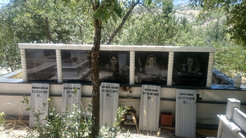
Figure 1 Graves of five guerrillas of Liberation Army of the Workers and Peasants of Turkey (Türkiye İşci ve Köylü Kurtuluş Ordusu in Turkish, TİKKO) died in 2011 due to the collapse of the winter barrack they were staying in. The death date is not marked on the grave.
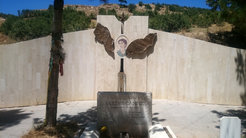
(Partiya Karkerên Kurdistan, PKK).
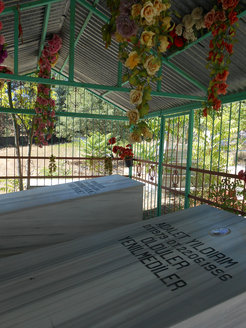
Some expressions on the graves explicitly reject death as an end point, such as the slogan of “Martyrs are immortal”[2] and the practice of not marking the death date. Others keep the martyr alive implicitly by making them a part of the movement’s temporality, for instance through slogans like “They died but were not defeated”[3] or “We die as one, but come back as thousands”[4] point. However, common to these resting places of revolutionary martyrs, even if they belong to different political movements, is the attempt to express that the afterlives of dead bodies have political potency. Their grave is a site where the sense of continuity between the past and the present is established in order to forge the future prospect of the movement. The sense of continuity created through slogans and practices generates an inclusive time frame of revolutionary victory, which has not happened yet but is projected onto the future. The victory also belongs to those who were martyred and contributed with their lives to its arrival/achievement. The martyr unifies with the “cause” and gets embodied in its temporality through dying. In this temporal frame, time flows towards the telos of revolution and the dead bodies of guerillas are kept alive thanks to their contribution to that telos. In other words, the afterlife of these dead bodies operates within the political legacy produced by the temporalities that are flowing towards the telos of revolution. In that sense, the grave of a martyr finds its place in a greater narrative and becomes a site to regenerate the revolutionary struggle’s temporality. This process allows not only to make sense of death or establish a grief regime for those who are still alive but also renders the grave a politically potent place where the revolutionary narrative is kept alive. In that sense, dying for a cause that is greater than the individual makes the grave of a martyr a site where the loss of the past connects with the ones who are alive to cultivate the future prospect of the movement that the dead body belongs to.
A Site for Magical Afterlife: Şeywuşen’s Grave
Completing the tour and returning to the entrance point, one encounters another grave, turned almost black due to the smoke of the candles that have been lightened on all sides. The grave of Şeywuşen is accompanied with a poem which also negates his death, but it does so differently than is the case at the martyr graves. “Death is not where the world ends/ I understood that with you”.[5] The poem continues elaborating a continuity between Şeywuşen’s life and afterlife with references to the Munzur river, mountains and the sun, which are attributed holiness in the region: “And you stand at the top of the mountains/ Wondering where the Sun is rising/ Surrendered by the broken statues of Gods/ You are the only one standing up/Sleeping like an innocent child/And Munzur is flowing next to your feet/You are touching the water and drawing things on it/Who knows what you are thinking?”[6] While the entire poem quoted above is inscribed on the statue Şeywuşen was granted after his tragic death in Dersim’s city center, only the last four lines were inscribed on the gravestone: “You are smiling to our callused heart and frozen face/ Tell us Seyit Hüseyin, why in such a rush? / Are you going to that unknown city?”[7]
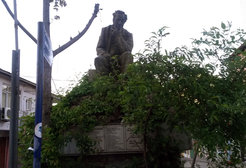
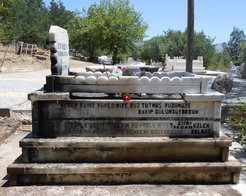
While the elements referring to the religious cosmology that Şeywuşen embodied and participated in – such as the sun and the holy Munzur river and mountains – were left out in the part inscribed onto the gravestone, Şeywuşen’s grave is visited by female dominated crowds to get in contact with his holy capacities that were already known during his lifetime. The prophecies and miracles that made him popular started spreading widely after the coup of 1980, when the revolutionary leftist movements were brutally cracked down on and the Kurdish liberation movement along with the struggle for Alevi rights started flourishing. He became known for his abilities to predict upcoming dangers to protect people, to appear in dreams either to bring news or to offer protection against possible threats, and to reveal the truth in contested situations. His photographs started to be sold starting in the 1980s at wedding ceremonies and were displayed on the walls of private and public places next to photographs of revolutionary and/or politicized religious figures such as Che Guevara, Alevi revolutionary leader Ibrahim Kaypakkaya, the medieval Alevi poet Pir Sultan and the like.
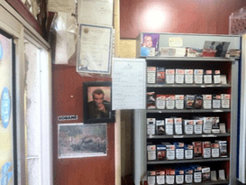
Şeywuşen’s definite entry into the Dersimi iconography is connected to his capacity to reveal a silenced truth in public space. Sleeping on the streets, Şeywuşen woke up they day following the 1980 coup – when a curfew had been imposed – and could not see anyone on the streets. When he saw a group of soldiers he approached them and asked where they took everyone to massacre them again. People in Dersim interpreted this phrase as an attempt to establish continuity between the silenced experience of the Dersim Genocide and the state terror of the 1980 coup, which marks the second 38 (Dersim Genocide) in the collective memory of Dersimis. Flashing up a wounded memory at a moment of danger, Şeywuşen appeared as a character suggesting a creative engagement with collective loss to make sense of contemporary violence, and took his place next to revered oppositional figures.
His grave represents a site where engagement with loss takes a different shape; a therapeutic one. People living in Dersim or in the diaspora come to visit his grave, light candles, make wishes, pray and cry while exchanging narratives of his prophecies in between gossip and everyday conversations. They take a piece of soil from his grave to become healed, get pregnant or find a benevolent partner. This therapeutic relationship is nourished both by the power of the holy lineage that Şeywuşen comes from and the power of Dersim’s landscape that has been accorded magical powers. Coming from the Kureşan lineage that is believed to be the continuation of the holy lineage of the Twelve Imams grants Şeywuşen not only the capacity to perform prophecies but also mobilize the holy capacity of natural sources. His grave is a site where his holy capacities generate the power to offer a therapeutic smile to ‘’callused heart and frozen face’’ as the poem on his grave indicates.
Among heavily politicized martyr graves, the grave of Şeywuşen remains a site where the history of state violence is expressed in implicit ways. The stories that associate his madness with state violence are not expressed on the grave stone. Instead, the emphasis was put on the negation of his death through a poem entitled You have not died. The attempt to keep Şeywuşen alive with a narrative that does not place his loss in any preestablished political narrative allows cultivating a creative engagement with his loss. While at martyr graves revolutionary movements are kept alive by commemorating the loss of individual militants, at the grave of Şeywuşen what is creatively brought back to today is the cosmology that was targeted during the Dersim Genocide.
While visiting the graves of revolutionary martyrs we are taken into the temporality of diverse revolutionary movements flowing towards different historical endpoints. When we stop at the grave of Şeywuşen we are taken into a cosmology grounded in the magical attributes of Dersim’s landscape, inhabited by members of holy lineages who organize everyday life with relative autonomy. It was this cosmology, along with lives of over ten thousand people and thousands more who were sent into exile, which the 1938 Dersim Genocide attempted to destroy. Situated in the savage slot starting from late Ottoman times due to racial and religious difference, Dersim has been occupying both imperial and national imaginaries of the constitutive Other. In that sense, the genocidal violence of 1938 indicates not only the peak of the fantasy of incorporation into the shared national time and space. It also connotes the brutal dispossession of the idea of relatively autonomous spaces within the Turkish state’s racialized and secularized rule.
Şeywuşen’s grave constitutes a site where the loss of the Dersim Genocide has been transformed into a capacity for healing. It operates as a site where one gets in touch with the wound of Dersim, heals oneself through this engagement and hopefully cultivates new generations. While negating death and including the afterlife into a temporality where past, present and future merge, unlike the martyr graves, the future prospect generated through this engagement is not faced towards a victorious future. Instead, it is faced towards an unreconciled past, which suggests open ending mourning instead of being healed by a victorious telos. Next to martyr graves that are generating narratives of enchantment with a revolutionary future prospect, the grave of Şeywuşen calls for a magical future prospect embedded in the wound of Dersim.
-------------------------------------
[1] The use of photography as a research medium in cemetery research complicates the question of temporality by capturing a moment that has already past and implicitly bringing the period of research on table through the presence of material traces from the fieldwork. Leaving elaborations on the temporal connotations of the medium of photography and the afterlife of the fieldwork aside for this short post I briefly would like to place the images in time. The photographs used in this post were taken between 2014 and 2018, a period of short and precarious ceasefire between the Kurdish liberation movement and the Turkish Armed Forces followed by brutal military clashes, as a part of my doctoral research.
[2] Şehitler ölmez!
[3] Öldüler yenilmediler!
[4] Bir ölür bin doğarız!
[5] Değil, ölüm dünyanın bittiği yer/Sende anladım bunu, sende çözdüm.
[6] Ve sen karşımda, dağlarımın yücesinde /Güneşin doğduğu yerde öyle bakmaktasın/ Etrafında yıkık Tanrı heykelleri/Aralarında bir tek sen ayaktasın/Uyumaktasın günahsız bir çocuk gibi/Ve Munzur akmakta ayaklarının önünde/Ellerinle suya dokunup bir şeyler çiziyorsun/Kim bilir Seyit Hüseyin neleri düşünüyorsun?
[7] Nasırlaşmış yüreğimize, buz tutmuş yüzümüze bakıp gülümsüyorsun/ söyle Seyit Hüseyin bu acele niye?/ Yoksa bilmediğimiz o şehre mi gidiyorsun?
















